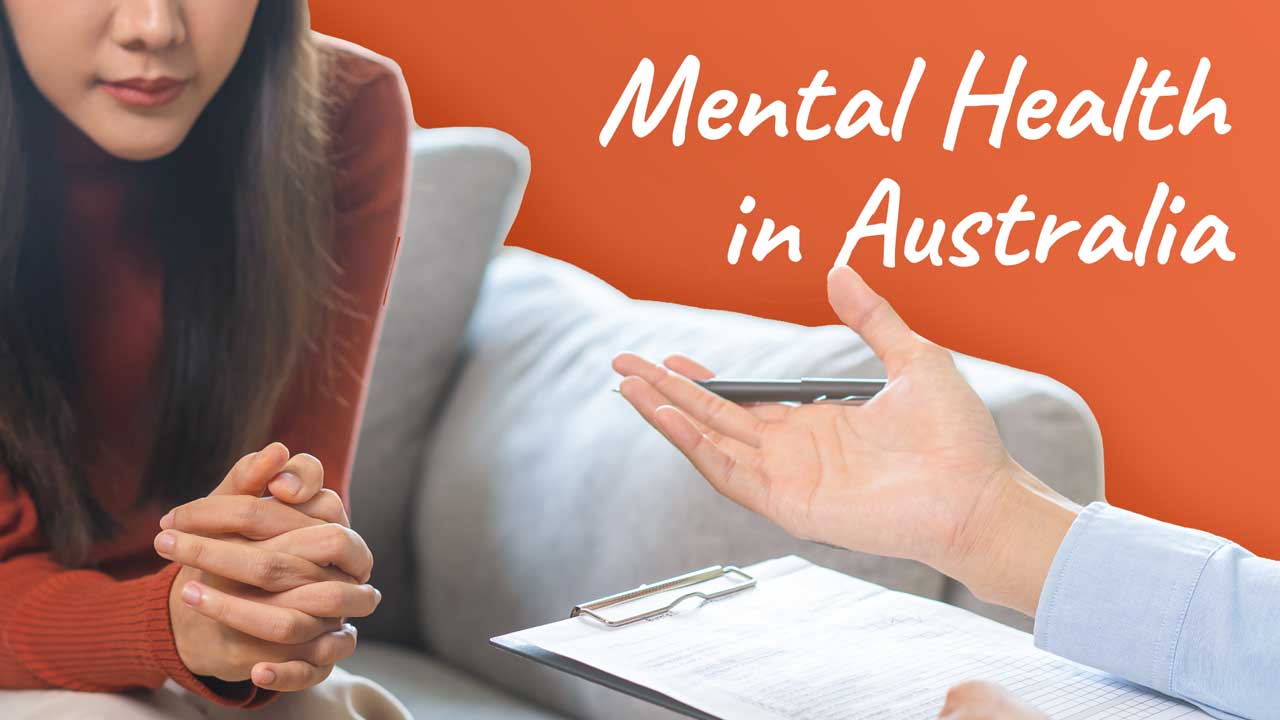In the most recent National Study of Mental Health and Wellbeing, it was found that almost 43% of Australian adults had experienced a mental disorder in their lifetime, with 21.5% experiencing a mental disorder in the previous year (ABS 2023).
The term ‘mental disorder’ covers a range of clinically diagnosable disorders that negatively impact an individual’s cognitive, emotional or social abilities (ABS 2023).
Currently, the most common mental health conditions in Australia are anxiety disorders, affective disorders and substance abuse disorders (AIHW 2024).

Mental Health Awareness
Mental health is defined by The World Health Organisation (2022) as:
‘A state of mental wellbeing that enables people to cope with the stresses of life, realise their abilities, learn well and work well and contribute to their community.’
If a person is not in this state of wellbeing and does not feel that it’s achievable, they may be living with a mental illness or mental health disorder. Prominent conditions include depression, anxiety, schizophrenia and bipolar disorders.
Note that while mental health disorders can and do affect all Australians, certain groups have a heightened risk of mental illness. These groups include:
- People living in residential care
- People who live in remote and regional areas
- Pregnant or new parents
- Aboriginal and Torres Strait Islander people are nearly three times more likely to be psychologically distressed than non-First Nations people
- LGBTIQ+ Australians
- Females are more likely than males to experience depression and anxiety (note, however, that males are considerably less likely to report or seek help for mental health conditions).
(Beyond Blue 2024)

Mental Health Treatment Plans
A Mental Health Treatment Plan (MHTP) is a support plan for someone experiencing mental health issues (Healthdirect 2023).
A general practitioner (GP) will assess if a person has signs of mental illness and whether they would benefit from mental health treatment (Healthdirect 2023).
General signs that a person may need to address their mental health include:
- They’ve been feeling one or more of the following for two weeks or more:
- Worried
- Sad
- Down
- Angry
- Depressed
- Numb
- Generally ‘not like themself’
- The way they’ve been feeling is affecting their ability to cope at work, school or in their relationships.
(Queensland Health 2024)
Not only does creating an MHTP allow a GP to refer someone to appropriate support, but it also gives the patient an opportunity to begin describing how they’ve been feeling, what their needs are and what results they would like.
In most cases, a MHTP is required to qualify for government-subsidised treatment through Medicare (Healthdirect 2023).
A MHTP may include the following:
- A referral to a health expert such as a psychologist, psychiatrist, occupational therapist, counsellor or social worker
- The type of mental healthcare a person can access
- Strategies to improve (and maintain) mental health.
(Headspace 2018)
Accessing Mental Health Services Under Medicare

Step 1 - Make an Appointment With a GP
Before an appointment with a GP or mental health professional, it is recommended that people write down a list of the things they want support with, such as feeling less anxious in certain situations or coping during depressive periods. It’s normal to feel nervous going into this appointment.
A list may be a helpful prompt and a useful backup. A patient could even give it to the health professional to read first and ask questions about what has been written down.
Step 2 - Talk to a GP About Mental Health Concerns
A GP will assess the patient’s mental health. They will need to diagnose the patient with a mental health condition to create the treatment plan. In order to do this, the GP will ask a series of personal questions to find out what’s been happening and how the patient has been feeling recently (Queensland Health 2024).
The patient may be asked to fill out a K10 form, which is a checklist intended to measure if and how a person has been affected by anxiety or depression over the past four weeks (Queensland Health 2024).
A mental health assessment conducted by a mental health clinician will likely consist of finding out the following:
- Presenting problems
- History of presenting problems
- Current functioning
- Relevant cultural issues
- Previous assessments and interventions
- Psychiatric history
- Current medications
- Medical history
- Family history
- Developmental history
- Substance use
- Forensic and legal history
- Risk screen
- Goals for treatment
- Mental status examination.
(Queensland Health 2010)
If a person is diagnosed as having a mental disorder, their GP may either prepare a MHTP or refer them to a psychiatrist who would create a psychiatrist assessment and management plan (PAMP) (DoHaAC 2024).
Step 3 - Be Referred to an Allied Health Service
A patient can be referred to Medicare-rebateable allied mental health services if they:
- Have a Mental Health Treatment Plan in place (note that a MHTP does not expire)
- Are being managed by a health practitioner under a referred psychiatrist assessment and management plan, or
- Are referred by a psychiatrist or paediatrician.
(DoHaAC 2024)
Step 4 - Attending Sessions
Initially, a GP, psychiatrist or paediatrician can refer a patient to treatment of up to six individual and six group allied mental health services. Treatment plans will vary depending on the individual and might involve psychological assessment and therapy by a clinical psychologist, or could consist of psychological strategies conducted by an allied mental health professional (DoHaAC 2024).
The number of allied mental health services to which a patient is referred is at the discretion of the referring practitioner (a maximum of six in any one referral) (DoHaAC 2024).
Step 5 - After the Six Sessions
Following the first round of treatment (six sessions or less), depending on the patient’s healthcare needs, they may want to return to their GP, psychiatrist, or paediatrician and obtain a new referral for additional sessions. The maximum number of individual and group services per calendar year is 10 (Services Australia 2023).
Conclusion
Obtaining a MHTP is a huge step towards becoming happier, healthier and more connected.
The difference mental health treatment can make to a person’s wellbeing cannot be overstated.
If you’re in crisis and need immediate support, call Lifeline on 13 11 14. Lifeline is open 24 hours a day, 7 days a week.
Test Your Knowledge
Question 1 of 3
Approximately how many Australian adults have experienced a mental disorder in the previous year?
Topics
References
- Australian Bureau of Statistics 2023, National Study of Mental Health and Wellbeing, Australian Government, viewed 12 December 2024, https://www.abs.gov.au/statistics/health/mental-health/national-study-mental-health-and-wellbeing/latest-release
- Australian Institute of Health and Welfare 2024, Prevalence and Impact of Mental Illness, Australian Government, viewed 12 December 2024, https://www.aihw.gov.au/mental-health/overview/mental-illness
- Beyond Blue 2024, Statistics, Beyond Blue, viewed 12 December 2024, https://www.beyondblue.org.au/media/statistics
- Department of Health and Aged Care 2024, Fact Sheet for Patients: Better Access to Psychiatrists, Psychologists and General Practitioners Through the MBS (Better Access) Initiative, Australian Government, viewed 12 December 2024, https://www.health.gov.au/sites/default/files/2024-07/better-access-fact-sheet-patients.pdf
- Headspace 2018, ‘Blog: How to Get a Mental Health Care Plan’, Headspace, 13 September, viewed 12 December 2024, https://headspace.org.au/explore-topics/for-young-people/mental-health-care-plan/
- Healthdirect 2023, Mental Health Treatment Plan, Australian Government, viewed 12 December 2024, https://www.healthdirect.gov.au/mental-health-treatment-plan
- Queensland Health 2010, What is a Mental Health Assessment?, Queensland Government, viewed 12 December 2024, https://www.health.qld.gov.au/__data/assets/pdf_file/0028/444592/assessment.pdf
- Queensland Health 2024, What is a Mental Health Care Plan and How do I Get One?, Queensland Government, viewed 12 December 2024, https://www.health.qld.gov.au/newsroom/features/what-is-a-mental-health-care-plan-and-how-do-I-get-one
- Services Australia 2023, Mental Health Care and Medicare, Australian Government, viewed 12 December 2024, https://www.servicesaustralia.gov.au/mental-health-care-and-medicare?context=60092
- World Health Organisation 2022, Mental Health, WHO, viewed 12 December 2024, https://www.who.int/news-room/fact-sheets/detail/mental-health-strengthening-our-response

